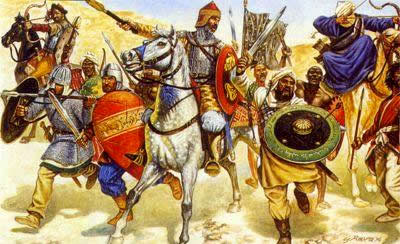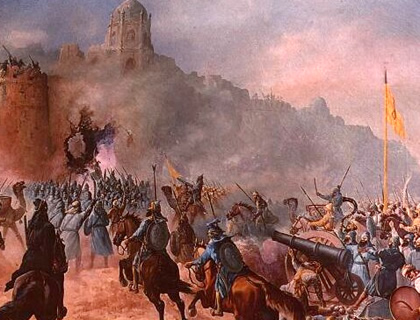World History
Sind (or Sindh) is a province of modern-day Pakistan. It is bounded by the Thar Desert to the east, the Kirthar Mountains to the west, and the Arabian Sea to the south.
The Indus River passes through Sind and its irrigation was a major source of food and revenue for Sindhi people. Buddhism was established in the area during the reign of King Ashoka, and adherence strengthened over the years.
Influence was exerted over the region by many different peoples, including the Scythians, Huns, Persians, Greco-Bactrians, and Mauryans. Chief Minister Chach seized the throne of Sind in 622 and established an unpopular dynasty that commanded little loyalty from the people or government officials.
Arabs had enjoyed a long and mostly untroubled relationship with Sind and its neighbors based mostly on shared commercial interests. Traders shipped goods from the Indian subcontinent and Southeast Asia westward to the Mediterranean.
This continued after the Arabs embraced Islam, but in 711 a dispute broke out following the attack on and enslavement of a group of women and children who were traveling to Arabia.
Hajjaj, the governor of the eastern provinces of the Umayyad Caliphate, complained but was unable to receive justice to his satisfaction and prepared for a military campaign. Two initial forays were repulsed but a third, led by Muhammad ibn Qasim, was more successful.
A force of 6,000 camels, 6,000 cavalry, and accompanying infantry and baggage train was dispatched and managed first to capture the coastal town of Dehul and then defeat the troops of King Dahar in battle, after a number of travails. The Arabs were assisted by the voluntary surrender of large numbers of Sindhi people and officials, whose loyalty to Dahar was very limited.
Muhammad ibn Qasim was able to establish control over the whole of Sind, which was subsequently integrated into the Umayyad Caliphate, where it remained during the succeeding Abbasid dynasty until central power loosened and it became possible to establish local dynasties.
The Abbasid governor, Hisham, who arrived in 757, undertook military expeditions against neighboring states, but there were no further territorial expansions throughout Arab rule.
Arab rule of Sind followed a similar pattern to that employed elsewhere, with most official posts remaining in local hands while an Arab governor administered the area with the assistance of troops who garrisoned the major towns and cities.
Some people converted to Islam but comparatively few, and there was little effort expended on forcing people to change their religion at that time. The Arab period of rule led to the creation of a fusion of cultures that have helped to characterize subsequent Sindhi society. The city of Mansura was established as the capital and its people benefited from Arab learning and knowledge.
- Abbasid Dynasty
Abbasid caliphate greatest extent The Abbasids defeated the Umayyads to claim the caliphate and leadership of the Muslim world in 750. The Abbasids based their legitimacy as rulers on their descent from the prophet Muhammad’s extended family, not...
- Sultan Muhammad Of Ghur
Sultan Muhammad of GhurThe victory of Muhammad of Ghur over the Rajput king, Prithviraj Chauhan III (r. 1178–92), was a turning point in the history of South Asia. Islam began to pervade the northern portion of the Indian subcontinent, in present-day...
- Rajput Confederacies
Rajput Confederacies Rajputs were members of the approximately 12 million landowners of northern India who claimed to be descended from the Kshatriya warrior caste. The name derives from the Sanskrit term Raja-putra, or “son of the king.â€...
- Battle Of Talas River
Battle of Talas River In 751 a Tang (T’ang) dynasty army commanded by Gao Xianzhi (Kao Hsien-chih), military governor of Anxi (An-hsi) in the Western Regions, met an Arab army in battle at Talas River near Samarkand. The Chinese were defeated....
- History Of Afghanistan
History of Afghanistan This is a general overview of the history of Afghanistan. For such a small area, this nations sure has a violent history. From the site: Afghanistan, often called the crossroads of Central Asia, has had a turbulent history....
World History
Arab conquest of Sind
 |
| Arab conquest of Sind |
Sind (or Sindh) is a province of modern-day Pakistan. It is bounded by the Thar Desert to the east, the Kirthar Mountains to the west, and the Arabian Sea to the south.
The Indus River passes through Sind and its irrigation was a major source of food and revenue for Sindhi people. Buddhism was established in the area during the reign of King Ashoka, and adherence strengthened over the years.
Influence was exerted over the region by many different peoples, including the Scythians, Huns, Persians, Greco-Bactrians, and Mauryans. Chief Minister Chach seized the throne of Sind in 622 and established an unpopular dynasty that commanded little loyalty from the people or government officials.
Arabs had enjoyed a long and mostly untroubled relationship with Sind and its neighbors based mostly on shared commercial interests. Traders shipped goods from the Indian subcontinent and Southeast Asia westward to the Mediterranean.
This continued after the Arabs embraced Islam, but in 711 a dispute broke out following the attack on and enslavement of a group of women and children who were traveling to Arabia.
Hajjaj, the governor of the eastern provinces of the Umayyad Caliphate, complained but was unable to receive justice to his satisfaction and prepared for a military campaign. Two initial forays were repulsed but a third, led by Muhammad ibn Qasim, was more successful.
 |
| Attacking Sind |
A force of 6,000 camels, 6,000 cavalry, and accompanying infantry and baggage train was dispatched and managed first to capture the coastal town of Dehul and then defeat the troops of King Dahar in battle, after a number of travails. The Arabs were assisted by the voluntary surrender of large numbers of Sindhi people and officials, whose loyalty to Dahar was very limited.
Muhammad ibn Qasim was able to establish control over the whole of Sind, which was subsequently integrated into the Umayyad Caliphate, where it remained during the succeeding Abbasid dynasty until central power loosened and it became possible to establish local dynasties.
The Abbasid governor, Hisham, who arrived in 757, undertook military expeditions against neighboring states, but there were no further territorial expansions throughout Arab rule.
Arab rule of Sind followed a similar pattern to that employed elsewhere, with most official posts remaining in local hands while an Arab governor administered the area with the assistance of troops who garrisoned the major towns and cities.
Some people converted to Islam but comparatively few, and there was little effort expended on forcing people to change their religion at that time. The Arab period of rule led to the creation of a fusion of cultures that have helped to characterize subsequent Sindhi society. The city of Mansura was established as the capital and its people benefited from Arab learning and knowledge.
- Abbasid Dynasty
Abbasid caliphate greatest extent The Abbasids defeated the Umayyads to claim the caliphate and leadership of the Muslim world in 750. The Abbasids based their legitimacy as rulers on their descent from the prophet Muhammad’s extended family, not...
- Sultan Muhammad Of Ghur
Sultan Muhammad of GhurThe victory of Muhammad of Ghur over the Rajput king, Prithviraj Chauhan III (r. 1178–92), was a turning point in the history of South Asia. Islam began to pervade the northern portion of the Indian subcontinent, in present-day...
- Rajput Confederacies
Rajput Confederacies Rajputs were members of the approximately 12 million landowners of northern India who claimed to be descended from the Kshatriya warrior caste. The name derives from the Sanskrit term Raja-putra, or “son of the king.â€...
- Battle Of Talas River
Battle of Talas River In 751 a Tang (T’ang) dynasty army commanded by Gao Xianzhi (Kao Hsien-chih), military governor of Anxi (An-hsi) in the Western Regions, met an Arab army in battle at Talas River near Samarkand. The Chinese were defeated....
- History Of Afghanistan
History of Afghanistan This is a general overview of the history of Afghanistan. For such a small area, this nations sure has a violent history. From the site: Afghanistan, often called the crossroads of Central Asia, has had a turbulent history....
